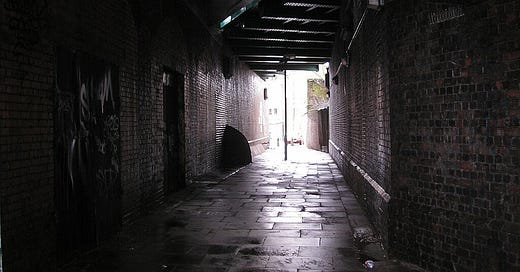Actor Prep Scene: London during the Blitz, 1943 – The Bethnal Green Disaster
Also For Screenwriters: Let's Rewrite A Forgotten Moment From History For Emotional Exploration
Here’s a powerful scene rewrite prompt and prep tool for actors, based on the Bethnal Green disaster during the London Blitz. It’s designed to help actors connect emotionally, physically, and historically — and to work without overexplaining the context.
Perfect for one-person scene work, monologue prep, or immersive exercises.
Background You Don’t Have To Say Out Loud
WW2. On 3 March 1943, 173 people — mostly women and children — died in a crush at the entrance to Bethnal Green Underground station during an air raid. There were no bombs. A new anti-aircraft weapon was fired nearby for the first time, and in the panic, the crowd surged. Families were trampled, suffocated, lost.
The British government suppressed the full story for years.
Scene Setup (For You, Not For The Audience)
You are Lea or Leonard, mid-30s, a local resident.
You’ve used the Bethnal Green shelter many times. On this night, you got out early.
Your child did not. Neither did your elderly mother.
This is the first time you’re speaking — to anyone — about what happened.
What’s Changed Since Then
– You haven’t slept more than 2 hours a night
– You refuse to go underground anymore
– You still haven’t collected their belongings
– A neighbour said, “At least it wasn’t a bomb.” You haven’t spoken since
Use This As A Monologue Prompt
🎭 Speak this scene aloud — slowly, brokenly, truthfully. Imagine you’re trying to explain it to someone who wasn’t there.
I heard the bang and I thought, again, already?
We knew what to do — get down, keep moving, don’t run.
I let go of her hand for one second.
It wasn’t a bomb. Not that time.
The noise came first, then the bodies.
It wasn’t falling from the sky — it was falling inwards.
Into the stairwell. Into itself.
There were no screams, not at first. Just coats and skin and silence.
My boy was under a boot. My mother’s hat — I saw it roll.
I shouted but the sound would stay in my mouth.
I think I climbed back up, or maybe I was pulled. I don’t remember.
They said we’d be safe underground.
Safe.
1. Actor’s Embodiment Guide
Work with these in your prep:
– What part of your body aches when you try to speak?
– Which sentence makes your voice break — and why?
– What do your hands do when you remember the crush?
– When do you stop making eye contact?
🎙️ Try it once in silence, then once in a whisper, then once shouting every third line. Each version tells you something new.
Bonus: Use An Object
Hold something small — a child’s mitten, a hairbrush, a shoe buckle.
Don’t name it. Just hold it as you speak. Let the audience wonder.
That’s how grief works.
2. Screenwriter’s Depth Guide
Use These Questions To Shape The Scene With Precision And Heart
Rewrite the scene.
However, writing the Bethnal Green disaster isn’t about recounting the event — it’s about letting us feel the aftershock in someone’s body.
To bring that to the page, work with these:
– What doesn’t your character say — and why not? Or just hint to?
– What moment hurts to write?
– Where does their language fail them — mid-sentence, mid-breath?
– What object sits between them and the person they’re speaking to?
– When does silence carry more tension than words?
✍️ Try writing three versions of the same moment:
✅ One with no dialogue — just action and body language
✅ One where the character tries and fails to speak
✅ One where they tell the story, but lie — and we know it
Then ask: Which version feels like the truth?
🎥 Write for breath, gesture, and silence — not exposition.
That’s what lets actors work, and audiences feel.
Conclusion: From One Stairwell To Every Story
This scene — one moment, one disaster, one survivor — was never just about Bethnal Green.
For you as an actor, it was a way to enter history through the body, through hesitation, through grief that resists language.
For you as a screenwriter, it was a chance to trade exposition for emotional architecture — to build tension not from bombs, or from being crushed to death by other humans, but from silence and breath.
What we aimed to achieve here was simple:
✅ To move from fact to feeling
✅ From document to drama
✅ From historical event to human experience
Now widen the lens. Could you do the same with a soldier at a forgotten checkpoint? A girl in a ration queue? A priest locking the door during a raid?
Let this exercise remind you:
You don’t have to explain the entire war.
You just have to make us care about one moment — and trust that it will echo.
Or delve deeper with The Cabinet of Forgotten Feelings where we do similar work.
The Cabinet of Forgotten Feelings isn’t just an archive — it’s a way in.
Each scene begins with a historical object and one unspoken emotion.
If you're preparing for a role in the past, get The Cabinet now and start where memory lingers.




